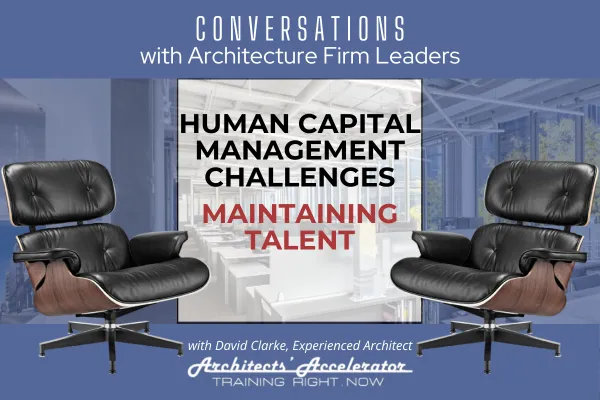
Conversations with Architecture Firm Leaders: Human Capital Management Challenges - Maintain Talent
These are conversations with architecture firm leaders.
I'm David Clarke. I've been in architecture for 40 years, a licensed architect for 35 years.
I help architecture firms be more profitable by building their staff to be more capable and competent.
The key areas that help people in your firm is called Human Capital Management. It's the acquiring, maintaining, nurturing and strengthening of the people who run your projects, who actually get stuff done so that your firm can build revenue and make a profit and stay profitable.
Last time I talked about Talent Acquisition. This time, Maintaining the people you already have.
Every firm has concerns about keeping the people you have, and that's no surprise. It's really challenging when you have already spent a lot of money on Talent Acquisition. You have made that investment, so now you want to keep them there. If they do leave, that makes a huge disruption in the projects that you are working on. You do not need more disruption.
Architecture firms are already delivering half of their projects late, and a third of their projects are over budget. So when people leave in the middle of a project, which is all the time that you're in the middle of a project, so anybody leaves at any given time, they give a two weeks notice, and that's disruption.
So it should come as no surprise that, according to Deltek’s survey, the most monitored metric for Human Resources is Voluntary Turnover. 73% of all firms reported the top monitoring metric is Voluntary Turnover. But in fact, over the last few years, Voluntary Turnover has actually gotten to be fairly stable. It's still high at 14% but if it's stable. That means it's predictable.
Let's say you've got a firm of 20 people, and you can count on about 14% voluntary turnover per year. That's two to three people per year. You can plan on that happening each year.
You can replace those people--go back into that talent acquisition process again--or do you have systems and software in place that will allow you to reduce your workforce? According to Deltek’s survey, 37% of all architecture firms in 2023 actually reduced their workforce. Everybody was coming out of the COVID disaster, and we had to recoup what was going on. We started building the firms back up again, but a lot of firms felt that they were doing pretty well with what they had. So they were able to reduce the number of people that they had.
But if you're going to maintain the people that you already have, how do you do that? Well, what are your competitors doing? According to the Deltek’s survey,
65% of architecture firms the number one thing that they're doing to retain their people is Employee Training And Development.
The number two is Building A Visible Career Path.
Number three is Increasing The Communication Between The Managers And Employees, essentially building a mentoring program, a structured mentoring program.
So let's focus on that first one, just for a moment. If you're being competitive, you want to engage in Employee Training And Development.
Large and medium sized firms, were able to implement employee development programs in half of all those firms. But with small firms, only 26% have structured training programs, and only 7% use software based Learning Management Systems. Now, Learning Management Systems are actually really expensive, and you're already paying for software for accounting and project development.
Small firms can afford structured training for their staff to build their development. And here's how:
Architects’ Accelerator has Architects’ FAST TRACK To LEADERSHIP System™.
If you go to https://architectsaccelerator.com/fasttrack, you'll find everything about the six week program that builds confidence, giving your staff the knowledge that they need to be project leaders, discussing clients and contractors and working with consultants and building project teams and thinking like a leader. They'll feel more confident in what they're doing, and they'll start enjoying their job more. When they enjoy their job more, they're more engaged. You'll get better quality, you'll get faster work done, maybe increase that level of projects being done on time and reduce the amount of projects that are over budget.
